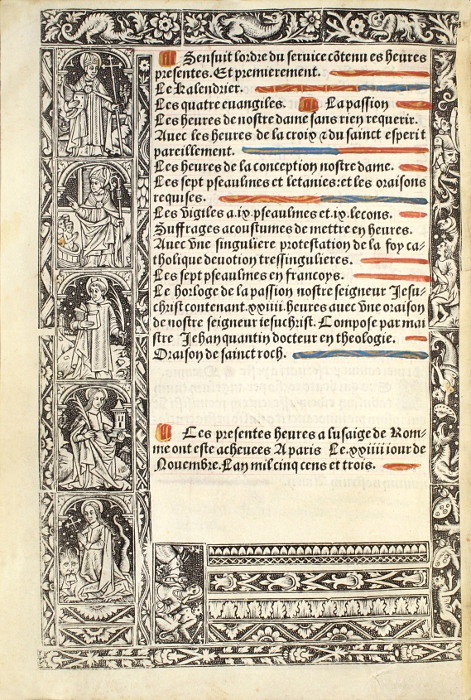Paris, Gillet Hardouin, 24 novembre 1503.
(Almanac 1497-1520). Large 8vo [215 x 150 mm] of 96 leaves on vellum of 31 line pages, signed A-M by 8, complete. Fawn calf, large border made of alternate fleur-de-lis medallions, floweret and pampre, underlined with small gilt fleur-de-lis, large central rectangle decorated with a pattern of gilt fleur-de-lis, with a large central oval of gilt foliage and large corner pieces, spine ribbed and decorated with fleur-de-lis, silver pieces on the corners, remains of ties, gilt edges. Brown morocco folder and case signed by Rivière & Son. French binding towards 1600.
Very fine book of Hours printed on vellum, one of the very first issued by the Hardouins still located at the Rose, on the Pont au Change, next to the beautiful image Nostre Dame. Brunet, V, 1630, n°222; Bohatta 769.
Gilles Hardouin only took the title of printer in 1509 when he set himself up “at the end of the pont Nostre Dame”. “For his very first productions, Gilles Hardouin had used the presses of Philippe Pigouchet, Anthoine Chappiel and particularly the ones of Guillaume Anabat.” Brunet, V, 1628
The iconography is composed, apart from the anatomic man leaf, of 14 large full page woodcuts, each of them contemporary illuminated with shimmering shades and placed in painted frames of a gilt background and large foliated pattern of floweret and fruits of the forest as well as 29 copper engravings each of them illuminated with gilt and many gilt initials on a blue or red background.
The large engravings represent: -The Crucifixion. -The Tree of Jess. -The Annunciation. -The Visitation. -The Crucifixion repeated here but painted differently. -The Pentecost. -The Nativity. -The Annunciation to the Shepherds. -The Adoration of the Magi. -The Presentation at the Temple. -The Flight into Egypt. -The Coronation of the Virgin. -King David. -The Fest of the bad rich.
Each of the pages of the book of Hours is also decorated with a border of many copper cuts representing episodes of the Old and New Testament. It is interesting to notice that all the legends and vignettes on the borders are in French
“These productions so remarkable for their xylographic ornaments and where the contemporary character marks the naïve poems they go with, have been almost entirely neglected during the seventeenth and the eighteenth century : as they became then almost useless as regards liturgy, and too common to be counted among the rare and precious books, it is only the copies decorated with rich paintings that found a place in the cabinet of curiosities, and only among the curiosities of secondary importance. No less than the revolution taking place in literature and in the arts since 1820 was necessary to bring back the public to the gothic genre, and to give a true importance to the books we are dealing with here. More sought-after, examined with more care, and especially more appreciated, these remarkable productions became a subject of admiration for artists and clever connoisseurs.” (Brunet, V, 1561).
Brunet emphasizes the rarity of book of Hours printed by the Hardouins, when they are rubricated and illuminated. “There are some quite precious copies, because of the paintings and illuminated letters that decorate them. It would seem that these gilt and colored letters are the work of Germain Hardouyn, ‘in arte litteriare picture peritissimus’ ». Brunet, V, 1628.
This book of Hours is particularly rare. Brunet notices that during the month of November 1503, Gilles Hardouin printed two different editions of this beautiful book of Hours: one under the date of November 24th (our copy), another one under the date of November 28th. Only the first one, presented here, is decorated with multitude of framed vignettes. Besides, its size is also larger: height of 210 mm to 193 mm for the following edition.
A precious and precocious book of Hours illuminated on vellum, remarkable for its bright colors and large size, preserved in an exquisite binding decorated with fleur-de-lis of which style in the floral medallions and the foliage ovals evokes the best Parisian workshops in the reign of Henry IV.
Provenance: Thomas Wynn, 1st Baron Newborough (1736-1807) with ex libris with arms; Boies Penrose (1860 Philadelphia-1921 Washington) with ex libris on vellum.






